|
|
|
Sort Order |
|
|
|
Items / Page
|
|
|
|
|
|
|
| Srl | Item |
| 1 |
ID:
165165


|
|
|
|
|
| Summary/Abstract |
How do periods of conflict and peace shape women's empowerment around the world? While existing studies have demonstrated that gender inequalities contribute to the propensity for armed conflict, we consider how the anticipation and realization of armed conflict shape women's opportunities for influence in society. Some scholars have pointed to the role that militarization and threat play in entrenching male dominance, while others have argued that periods of warfare can upend existing gender hierarchical orders. We posit mechanisms by which the preparation for and experiences during war affect change in women's empowerment. We develop and test observable implications using cross-national data from 1900 to 2015. We find that, at least in the short and medium term, warfare can disrupt social institutions and lead to an increase in women's empowerment via mechanisms related to role shifts across society and political shifts catalyzed by war. Reforming institutions and mainstreaming gender during peace processes stand to have important legacies for gender power relations in postconflict societies, though much more may be needed for more permanent change.
|
|
|
|
|
|
|
|
|
|
|
|
|
|
|
|
| 2 |
ID:
143326


|
|
|
|
|
| Summary/Abstract |
Sexual exploitation and abuse (SEA) is an endemic problem in UN peacekeeping missions. It is not only a gross human rights violation, but also threatens to challenge the legitimacy of the peacekeeping mission and undermines the promotion of gender equality in host countries. We examine if the composition of peacekeeping forces along two dimensions – the proportion of women and the records of gender (in)equality in the contributing countries – helps explain variation in SEA allegations. Analysis of mission-level information from 2009 to 2013 indicates that including higher proportions of both female peacekeepers and personnel from countries with better records of gender equality is associated with lower levels of SEA allegations reported against military contingents. We conclude that substantial reductions in SEA perpetrated by peacekeepers requires cultivation of a value for gender equality among all peacekeepers – improving the representation of women may help but still stops short of addressing the root of the problem.
|
|
|
|
|
|
|
|
|
|
|
|
|
|
|
|
| 3 |
ID:
111739
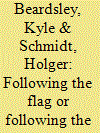

|
|
|
|
|
| Publication |
2012.
|
| Summary/Abstract |
This paper compares the explanatory power of two models of UN intervention behavior: (i) an "organizational mission model" built around the proposition that variations in the amount of resources that the UN devotes to different conflicts primarily reflect the degree to which a conflict poses a challenge to the UN's organizational mandate of promoting international peace and stability and (ii) a "parochial interest model" that revolves around the purely private interests of the five veto-holding members of the UN Security Council (the so-called P-5), i.e., interests that are either unrelated to or at odds with the UN's organizational mandate. Examining data on UN conflict management efforts in more than 270 international crises between 1945 and 2002, we find that measures of the severity and escalatory potential of a conflict are significantly better predictors of the extent of UN involvement in international crises than variables that measure P-5 interests that do not align with the UN's organizational mission of acting as a global peacemaker. This suggests that the UN adheres more closely to the humanitarian and security mission laid out in its Charter than critics of the organization often suggest.
|
|
|
|
|
|
|
|
|
|
|
|
|
|
|
|
| 4 |
ID:
167380
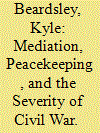

|
|
|
|
|
| Summary/Abstract |
One of the proposed benefits of third-party involvement that has been offered to justify its use is that it helps reduce the severity of conflict. Existing work finding that peacekeeping operations reduce battle-related fatalities considers peacekeeping in isolation from other forms of third-party diplomatic involvement, such as mediation. We argue that mediation has its own effect on patterns of violence. Moreover, we argue that peacekeeping and mediation can have an interactive effect, in which each enhance the violence-reducing potential of the other. Using monthly data on battle-related deaths in African intrastate conflicts, we find that mediation is associated with reduced bloodshed. We also find, consistent with existing work, that a greater number of peacekeepers leads to a reduction in violence. In addition, we find that mediation and peacekeeping efforts reinforce one another, although each type of involvement is able to reduce battlefield fatalities independently.
|
|
|
|
|
|
|
|
|
|
|
|
|
|
|
|
| 5 |
ID:
065706
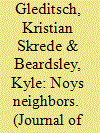

|
|
|
| 6 |
ID:
177859


|
|
|
|
|
| Summary/Abstract |
Despite the importance of having continuity in third-party involvement, many third parties lack the ability to commit as long-term peace guarantors. We argue that non-state actors and third parties with vested interests in peace and stability will be more likely to sustain involvement in post-conflict periods. Analysis of monthly level data from the Managing Intrastate Conflict (MIC) project confirms that third parties that have had wartime experience as conflict managers are more likely to get involved in post-conflict peace processes, regardless of whether the conflict management is in the form of peacekeeping missions, mediation or good offices; regardless of whether the third party is geographically proximate; and regardless of whether the third party is a state or non-state actor. The results also confirm that third-party geographic proximity and other measures of vested interests additively increase the propensity for postwar involvement. However, wartime conflict management experience matters less for third parties with vested interests, suggesting the additional importance of demand-side determinants of third-party conflict management.
|
|
|
|
|
|
|
|
|
|
|
|
|
|
|
|
| 7 |
ID:
137788


|
|
|
|
|
| Summary/Abstract |
A rich literature has developed focusing on the efficacy of peacekeeping operations (PKOs) in a temporal sense—asking whether the periods following a deployment are more peaceful or not. We know less about the efficacy of PKOs in a spatial sense. Can peacekeeping shape the geographic dispersion of particular episodes of violence? We posit that PKOs can contain conflict by decreasing the tactical advantage of mobility for the rebels, by obstructing the movement of armed actors, and by altering the ability for governments to seek and confront rebel actors. We investigate the observable implications using georeferenced conflict polygons from the Uppsala Conflict Data Program's (UCDP) Georeferenced Event Dataset (GED). Our findings confirm that PKOs tend to decrease movement in the conflict polygons, especially when robust forces are deployed and when rebel groups have strong ethnic ties. Our findings, on the one hand, imply that PKOs reduce the geographic scope of violence. On the other hand, PKOs may allow nonstate actors to gain strength and legitimacy and thus constitute an even greater future threat to the state whether some form of accord is not reached.
|
|
|
|
|
|
|
|
|
|
|
|
|
|
|
|
| 8 |
ID:
076875


|
|
|
|
|
| Publication |
2007.
|
| Summary/Abstract |
The literature on international conflict is divided on the impact of nuclear proliferation on state conflict. The optimists' argument contends that nuclear weapons raise the stakes so high that states are unlikely to go to war when nuclear weapons enter the equation. The pessimists rebut this argument, contending that new proliferators are not necessarily rational and that having nuclear weapons does not discourage war but rather makes war more dangerous. Focusing on one observable implication from this debate, this article examines the relationship between the severity of violence in crises and the number of involved states with nuclear weapons. The study contends that actors will show more restraint in crises involving more participants with nuclear weapons. Using data from the International Crisis Behavior (ICB) project, the results demonstrate that crises involving nuclear actors are more likely to end without violence and, as the number of nuclear actors involved increases, the likelihood of war continues to fall. The results are robust even when controlling for a number of factors including non-nuclear capability. In confirming that nuclear weapons tend to increase restraint in crises, the effect of nuclear weapons on strategic behavior is clarified. But the findings do not suggest that increasing the number of nuclear actors in a crisis can prevent war, and they cannot speak to other proliferation risks.
|
|
|
|
|
|
|
|
|
|
|
|
|
|
|
|
| 9 |
ID:
091069
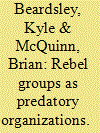

|
|
|
|
|
| Publication |
2009.
|
| Summary/Abstract |
In this article we propose a new typology for insurgent groups to explain why in such remarkably similar conflicts-Sri Lanka and Aceh-the impact of the 2004 Indian Ocean Tsunami was so different. We argue that two principal factors shape all rebel groups by defining their incentive structures: the efficiency of the return on investment of the primary source(s) of support and the group's territorial objectives. The former factor is especially strong in explaining the different choices made by the LTTE and GAM. In Sri Lanka, the availability of lucrative resources outside the country has made the LTTE leadership inimical to compromise, threatened by relief aid, and less reliant on the local population. Lacking access to such high-return funding sources, GAM on the other hand was more closely linked to the needs of the local population and found greater value in both outside aid and a comprehensive settlement.
|
|
|
|
|
|
|
|
|
|
|
|
|
|
|
|
| 10 |
ID:
141849


|
|
|
|
|
| Summary/Abstract |
The fighting in some civil wars primarily takes place in a few stable locations, while the fighting in others moves substantially. We posit that rebel groups that do not primarily fight for a specific ethnic group, that receive outside military assistance, or that have relatively weak fighting capacity tend to fight in inconsistent locations. We develop new measures of conflict zone movement to test our hypotheses, based on shifts in the conflict polygons derived from the new Georeferenced Event Dataset (GED) developed by the Uppsala Conflict Data Program (UCDP). Our empirical results provide support for the suggested mechanisms. We find that groups which lack strong ethnic ties and sufficient military strength to compete with government forces in conventional warfare fight in more varied locations. These findings improve our understandings of and expectations for variations in the humanitarian footprint of armed conflicts, the interdependencies between rebel groups and local populations, and the dilemmas faced by government counterinsurgency efforts.
|
|
|
|
|
|
|
|
|
|
|
|
|
|
|
|
| 11 |
ID:
068972


|
|
|
| 12 |
ID:
128986
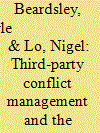

|
|
|
|
|
| Publication |
2014.
|
| Summary/Abstract |
Third-party conflict management, particularly legal dispute resolution (arbitration and adjudication) and mediation, can help improve the willingness of disputants to make asymmetric concessions by ameliorating commitment problems and providing political cover. In both regards, and especially pertaining to commitment problems, mediation has substantial limitations when compared to legal dispute resolution. We develop these arguments and test the observable implications on the Issue Correlates of War data. To get traction on the mechanisms at work, we distinguish between challenger concessions and defender concessions, positing that challenger concessions face the primary hurdle of political cover while defender concessions face the primary hurdle of commitment problems. We find that legal dispute resolution strongly increases the propensity for concessions by both challengers and targets, even major asymmetric concessions. Mediation, on the other hand, only helps increase minor challenger concessions. Also consistent with expectations, mediation best enables asymmetric challenger concessions in the highly salient cases that need the most political cover, and legal dispute resolution best enables asymmetric concessions when there has been a history of failed conflict management attempts that perpetuate mistrust.
|
|
|
|
|
|
|
|
|
|
|
|
|
|
|
|
| 13 |
ID:
112780
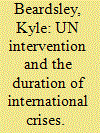

|
|
|
|
|
| Publication |
2012.
|
| Summary/Abstract |
This article examines the effect of UN actions on the duration of international crises. Four different types of action - assurance, diplomatic engagement, military involvement, and intimidation - and three different outcomes - compromise, victory, and stalemate - are considered. After building on the existing literature to develop expectations of how a third party like the UN shapes crisis trajectories, hypotheses are tested using the International Crisis Behavior (ICB) data and a new events dataset on UN activity. Results from competing-risks models reveal that UN military involvement does well to decrease the risk of one side achieving victory, and diplomatic engagement increases the ability of the belligerents to reach a compromise in the long run. Moreover, diplomatic engagement accompanied by military involvement substantially hastens the pace of stalemate outcomes. Both tactics, however, have some trade-offs. Military involvement can decrease the sense of urgency for compromise; diplomatic engagement can be used for insincere motives and increase the risk of one-sided victory over time. UN actions of assurance and simple intimidation have considerable shortcomings as crisis management vehicles.
|
|
|
|
|
|
|
|
|
|
|
|
|
|
|
|
| 14 |
ID:
087449
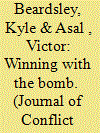

|
|
|
|
|
| Publication |
2009.
|
| Summary/Abstract |
Nuclear weapons' effects on an actor's success in coercive diplomacy are in part a function of how nuclear weapons change the perceived costs of conflict. The authors argue that states can improve their allotment of a good or convince an opponent to back down and have shorter crises if their opponents have greater expected costs of crisis. Noting that nuclear weapons increase the costs of full-escalation scenarios but decrease their probability, it is uncertain what impact nuclear weapons should have on expected costs of conflict. The authors assess crisis outcomes from 1945 to 2000 using the International Crisis Behavior data set. The evidence confirms that nuclear actors are more likely to prevail when facing a nonnuclear state. The expected duration of crisis in such asymmetric directed dyads is substantially smaller than the duration of crisis for actors in nonnuclear dyads. Nuclear actors in asymmetric dyads are also more likely to prevail than states in symmetric nuclear dyads.
|
|
|
|
|
|
|
|
|
|
|
|
|
|
|
|
|
|
|
|
|